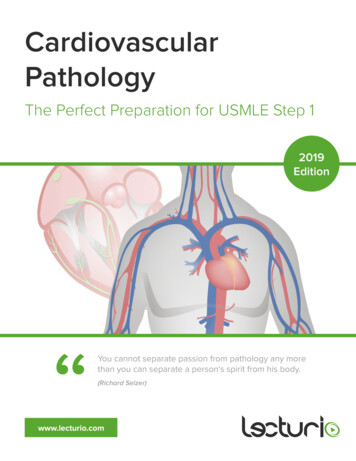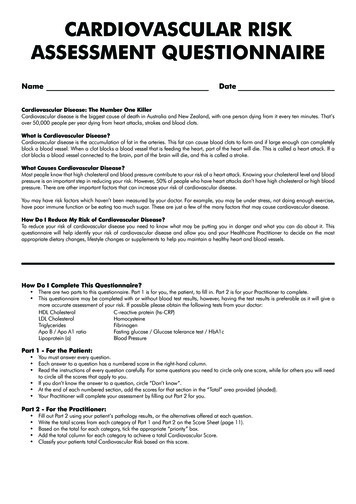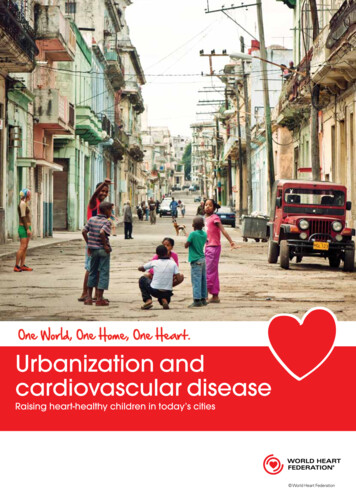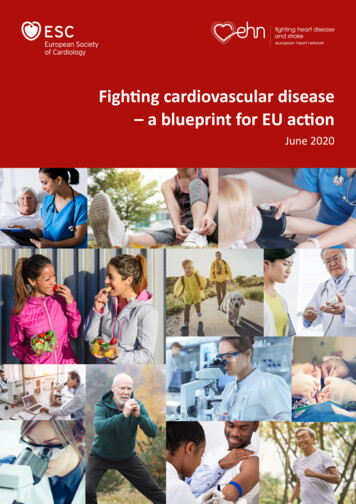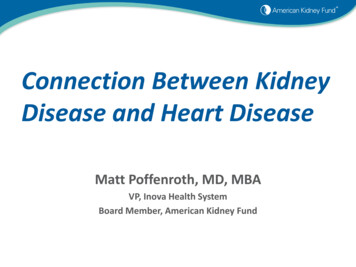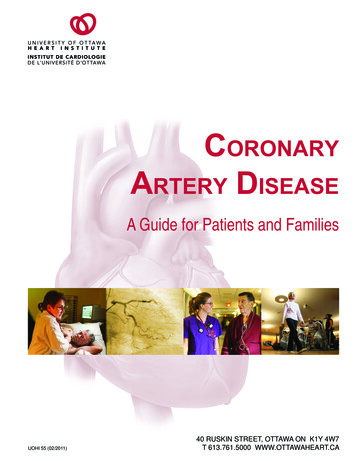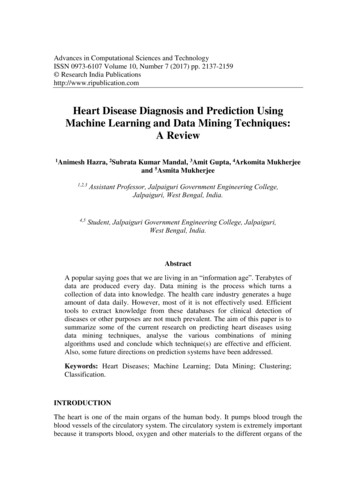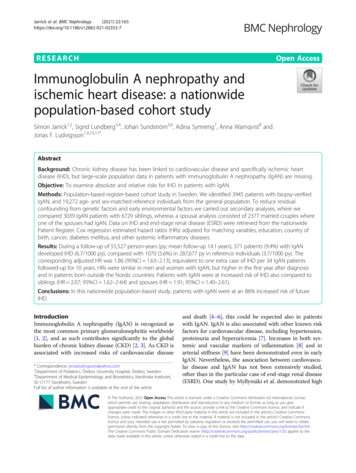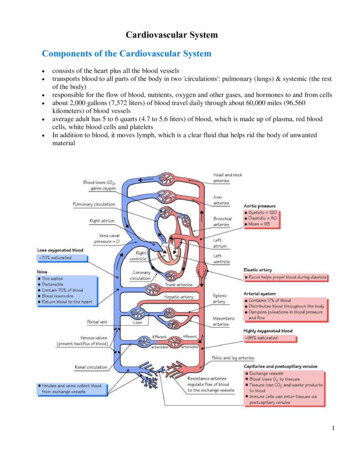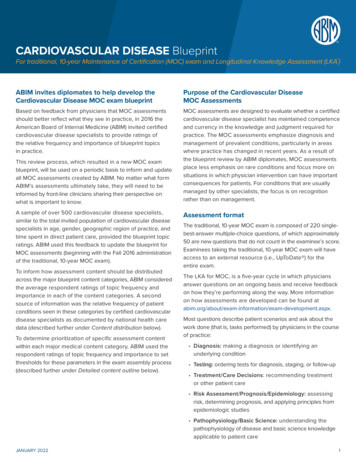
Transcription
CARDIOVASCULAR DISEASE BlueprintFor traditional, 10-year Maintenance of Certification (MOC) exam and Longitudinal Knowledge Assessment (LKA )ABIM invites diplomates to help develop theCardiovascular Disease MOC exam blueprintPurpose of the Cardiovascular DiseaseMOC AssessmentsBased on feedback from physicians that MOC assessmentsshould better reflect what they see in practice, in 2016 theAmerican Board of Internal Medicine (ABIM) invited certifiedcardiovascular disease specialists to provide ratings ofthe relative frequency and importance of blueprint topicsin practice.MOC assessments are designed to evaluate whether a certifiedcardiovascular disease specialist has maintained competenceand currency in the knowledge and judgment required forpractice. The MOC assessments emphasize diagnosis andmanagement of prevalent conditions, particularly in areaswhere practice has changed in recent years. As a result ofthe blueprint review by ABIM diplomates, MOC assessmentsplace less emphasis on rare conditions and focus more onsituations in which physician intervention can have importantconsequences for patients. For conditions that are usuallymanaged by other specialists, the focus is on recognitionrather than on management.This review process, which resulted in a new MOC examblueprint, will be used on a periodic basis to inform and updateall MOC assessments created by ABIM. No matter what formABIM’s assessments ultimately take, they will need to beinformed by front-line clinicians sharing their perspective onwhat is important to know.A sample of over 500 cardiovascular disease specialists,similar to the total invited population of cardiovascular diseasespecialists in age, gender, geographic region of practice, andtime spent in direct patient care, provided the blueprint topicratings. ABIM used this feedback to update the blueprint forMOC assessments (beginning with the Fall 2016 administrationof the traditional, 10-year MOC exam).To inform how assessment content should be distributedacross the major blueprint content categories, ABIM consideredthe average respondent ratings of topic frequency andimportance in each of the content categories. A secondsource of information was the relative frequency of patientconditions seen in these categories by certified cardiovasculardisease specialists as documented by national health caredata (described further under Content distribution below).To determine prioritization of specific assessment contentwithin each major medical content category, ABIM used therespondent ratings of topic frequency and importance to setthresholds for these parameters in the exam assembly process(described further under Detailed content outline below).Assessment formatThe traditional, 10-year MOC exam is composed of 220 singlebest-answer multiple-choice questions, of which approximately50 are new questions that do not count in the examinee’s score.Examinees taking the traditional, 10-year MOC exam will haveaccess to an external resource (i.e., UpToDate ) for theentire exam.The LKA for MOC, is a five-year cycle in which physiciansanswer questions on an ongoing basis and receive feedbackon how they’re performing along the way. More informationon how assessments are developed can be found .aspx.Most questions describe patient scenarios and ask about thework done (that is, tasks performed) by physicians in the courseof practice: Diagnosis: making a diagnosis or identifying anunderlying condition Testing: ordering tests for diagnosis, staging, or follow-up Treatment/Care Decisions: recommending treatmentor other patient care Risk Assessment/Prognosis/Epidemiology: assessingrisk, determining prognosis, and applying principles fromepidemiologic studies Pathophysiology/Basic Science: understanding thepathophysiology of disease and basic science knowledgeapplicable to patient careJANUARY 20221
Clinical scenarios presented take place in outpatient orinpatient settings as appropriate to a typical cardiovasculardisease practice. Some questions require interpretation ofpictorial material including electrocardiograms, intracardiacelectrograms, hemodynamic recordings, chest radiographs,photomicrographs, and imaging studies such as coronaryangiograms, echocardiograms, ventriculograms, myocardialperfusion images, computed tomographs, magnetic resonanceimages, and intravascular ultrasound images. Some questionsmay also require recognition and interpretation of recordedheart sounds.Exam tutorials, including examples of question formats,can be found at ent distributionListed below are the major medical content categories thatdefine the domain for the Cardiovascular Disease traditional,10-year MOC exam and the LKA. The relative distribution ofcontent is expressed as a percentage of the total assessment.To determine the content distribution, ABIM considered theaverage respondent ratings of topic frequency and importance.To cross-validate these self-reported ratings, ABIM alsoconsidered the relative frequency of conditions seen inMedicare patients by a cohort of certified cardiovasculardisease specialists. Informed by these data, the CardiovascularDisease Approval Committee and Cardiovascular Board havedetermined the medical content category targets shown below.MEDICAL CONTENT CATEGORYArrhythmiasCoronary Artery DiseaseTarget %15%21.5%Heart Failure and Cardiomyopathy19%Valvular Disease15%Pericardial Disease3%Congenital Heart Disease3%Vascular Diseases5%Systemic Hypertension and Hypotension8.5%Pulmonary Circulation Disorders3%Systemic Disorders Affecting theCirculatory System7%TotalJANUARY 2022100%Assessment questions in the content areas above may alsoaddress clinical topics in: Preventive and rehabilitative cardiology Cardiovascular disease in women Geriatric cardiovascular disease Preoperative assessment for noncardiac surgery Postoperative cardiac care C ritical care medicine, cardiovascular surgery, andgeneral internal medicine as encountered in the practiceof cardiology (including some general pediatrics with anemphasis on adolescent medicine)How the blueprint ratings are used to assemblethe MOC assessmentBlueprint reviewers provided ratings of relative frequency inpractice for each of the detailed content topics in the blueprintand provided ratings of the relative importance of the topicsfor each of the tasks described in Assessment format above.In rating importance, reviewers were asked to considerfactors such as the following: High risk of a significant adverse outcome Cost of care and stewardship of resources Common errors in diagnosis or management Effect on population health Effect on quality of life When failure to intervene by the physician deprivesa patient of significant benefitFrequency and importance were rated on a three-point scalecorresponding to low, medium, or high. The median importanceratings are reflected in the Detailed content outline below.The Cardiovascular Disease Approval Committee andCardiovascular Board, in partnership with the physiciancommunity, have set the following parameters for selectingMOC assessment questions according to the blueprintreview ratings: A t least 88% of questions will address high-importancecontent (indicated in green) No more than 12% of questions will address mediumimportance content (indicated in yellow) No questions will address low-importance content(indicated in red).Independent of the importance and task ratings, no morethan 18% of questions will address low-frequency content(indicated by “LF” following the topic description).2
The content selection priorities below are applicable beginning with the Fall 2016 traditional, 10-year MOC exam and are subject tochange in response to future blueprint review.Note: The same topic may appear in more than one medical content category.Detailed content outline for the Cardiovascular Disease traditional, 10-year MOC exam and the LKA–H igh Importance: At least 88% of questionswill address topics and tasks with thisdesignation.–M edium Importance: No more than 12%of questions will address topics and taskswith this designation.–L ow Importance: No questions willaddress topics and tasks withthis designation.LF – Low Frequency: No more than 18% of questions will address topics with this designation, regardless of task or importance.ARRHYTHMIAS(15% of exam)DiagnosisTestingTreatment/Care DecisionsRisk asic ScienceATRIOVENTRICULAR CONDUCTION DISEASE ( 2% of exam)Atrioventricular block, 1st degreeAtrioventricular block, 2nd degreeAtrioventricular block, completeLeft bundle branch blockRight bundle branch blockLeft anterior fascicular blockLeft posterior fascicular blockLFSINUS NODE DYSFUNCTION ( 2% of exam)Sinus bradycardiaSinus pausesBradycardia-tachycardia syndromeSUPRAVENTRICULAR ARRHYTHMIAS (2% of exam)Atrioventricular reentrant nodaltachycardiaPre-excitation syndromes(including Wolff-Parkinson-White)LFAtrioventricular reciprocatingtachycardiaLFJANUARY 20223
–H igh Importance: At least 88% of questionswill address topics and tasks with thisdesignation.–M edium Importance: No more than 12%of questions will address topics and taskswith this designation.–L ow Importance: No questions willaddress topics and tasks withthis designation.LF – Low Frequency: No more than 18% of questions will address topics with this designation, regardless of task or importance.ARRHYTHMIAScontinued (15% of exam)DiagnosisTestingTreatment/Care DecisionsRisk asic ScienceVENTRICULAR ARRHYTHMIAS (2% of exam)Ventricular tachycardia,monomorphicVentricular tachycardia, polymorphicWith prolonged Q-T intervalWithout prolonged Q-T intervalVentricular fibrillation (includingidiopathic and non-idiopathicvarieties)LFPremature ventricular complexATRIAL ARRHYTHMIAS (3.5% of exam)Paroxysmal atrial fibrillationPersistent atrial fibrillationPermanent atrial fibrillationTypical atrial flutter (Type I)Atypical atrial flutter (Type II)Atrial tachycardiaEctopic atrial rhythmsCHANNELOPATHIES ( 2% of exam)Long Q-T syndromeLFBrugada syndromeLFEarly repolarization syndromeSUDDEN CARDIAC DEATH ( 2% of exam)Sudden cardiac deathJANUARY 20224
–M edium Importance: No more than 12%of questions will address topics and taskswith this designation.–H igh Importance: At least 88% of questionswill address topics and tasks with thisdesignation.–L ow Importance: No questions willaddress topics and tasks withthis designation.LF – Low Frequency: No more than 18% of questions will address topics with this designation, regardless of task or importance.ARRHYTHMIASTestingTreatment/Care DecisionsRisk asic ScienceTestingTreatment/Care DecisionsRisk asic Sciencecontinued (15% of exam)DiagnosisSYNCOPE ( 2% of exam)SyncopePACEMAKER AND ICD FUNCTION ( 2% of exam)Pacemaker and ICD functionANTIARRHYTMIC DRUG EFFECTS ( 2% of exam)Antiarrhytmic drug effectsCORONARY ARTERY DISEASE(21.5% of exam)DiagnosisANGINA PECTORIS (5% of exam)Unstable anginaVasospastic anginaLFAngina equivalentExertional anginaAngina with microvascular diseaseCHRONIC ISCHEMIC HEART DISEASE (5% of exam)Coronary atherosclerosisRemote myocardial infarctionAneurysm of the heartLFCoronary artery aneurysmLFSilent myocardial ischemiaJANUARY 20225
–H igh Importance: At least 88% of questionswill address topics and tasks with thisdesignation.–M edium Importance: No more than 12%of questions will address topics and taskswith this designation.–L ow Importance: No questions willaddress topics and tasks withthis designation.LF – Low Frequency: No more than 18% of questions will address topics with this designation, regardless of task or importance.CORONARY ARTERY DISEASEcontinued (21.5% of exam)DiagnosisTestingTreatment/Care DecisionsRisk asic ScienceACUTE MYOCARDIAL INFARCTION (9.5% of exam)STEMI of the anterior wallSTEMI of the inferior wallRight ventricular involvementSTEMI of the lateral wallSTEMI of the posterior wall(including inferoposterior wall)Type I Non-STEMIType II myocardial infarctionSpontaneous coronary arterydissectionLFSTEMI, otherEARLY COMPLICATIONS FOLLOWING ACUTE MYOCARDIAL INFARCTION ( 2% of exam)Ventricular septal ruptureLFRupture of the cardiac wallLFRupture of papillary muscleLFPostinfarction anginaPostinfarction arrhythmiasLeft ventricular pseudoaneurysmLFDynamic left ventricular outflowtract obstructionLFPostinfarction systolic heart failureATYPICAL CHEST PAIN ( 2% of exam)Atypical chest painJANUARY 20226
–H igh Importance: At least 88% of questionswill address topics and tasks with thisdesignation.–M edium Importance: No more than 12%of questions will address topics and taskswith this designation.–L ow Importance: No questions willaddress topics and tasks withthis designation.LF – Low Frequency: No more than 18% of questions will address topics with this designation, regardless of task or importance.HEART FAILURE ANDCARDIOMYOPATHY(19% of exam)DiagnosisTestingTreatment/Care DecisionsRisk asic ScienceHEART FAILURE (9% of exam)Acute decompensated ventricularfailureSystolic heart failure (heart failurewith reduced ejection fraction)Diastolic heart failure (heart failurewith preserved ejection fraction)Heart failure with improved ejectionfractionCardiogenic shockCARDIOMYOPATHIES (8% of exam)Dilated cardiomyopathiesHypertrophic cardiomyopathiesRestrictive and cardiomyopathyLFStress-induced cardiomyopathy(takotsubo syndrome)MyocarditisLFNoncompaction cardiomyopathyLFArrhythmogenic right ventriculardysplasiaLFTRANSPLANTED HEART ( 2% of exam)Transplanted heartLFMECHANICAL CIRCULATORY SUPPORT ( 2% of exam)Mechanical circulatory supportJANUARY 2022LF7
–M edium Importance: No more than 12%of questions will address topics and taskswith this designation.–H igh Importance: At least 88% of questionswill address topics and tasks with thisdesignation.–L ow Importance: No questions willaddress topics and tasks withthis designation.LF – Low Frequency: No more than 18% of questions will address topics with this designation, regardless of task or importance.VALVULAR DISEASE(15% of exam)DiagnosisTestingTreatment/Care DecisionsRisk asic ScienceMITRAL VALVE DISORDERS (5.5% of exam)Mitral valve regurgitation, nativeMitral valve stenosis, nativeLFMitral valve prolapse, nativeProsthetic mitral valveAORTIC VALVE DISORDERS (4.5% of exam)Aortic valve regurgitation, nativeAortic valve stenosis, nativeProsthetic aortic valveTRICUSPID VALVE DISORDERS ( 2% of exam)Tricuspid valve regurgitation, nativeTricuspid valve stenosis, nativeLFProsthetic tricuspid valveLFPULMONARY VALVE DISORDERS ( 2% of exam)Pulmonary valve regurgitation,nativeLFPulmonary valve stenosis, nativeLFProsthetic pulmonary valveLFENDOCARDITIS (2% of exam)EndocarditisCARDIAC MURMURS AND OTHER CARDIAC SOUNDS ( 2% of exam)Cardiac murmurs and othercardiac soundsJANUARY 20228
–H igh Importance: At least 88% of questionswill address topics and tasks with thisdesignation.–M edium Importance: No more than 12%of questions will address topics and taskswith this designation.–L ow Importance: No questions willaddress topics and tasks withthis designation.LF – Low Frequency: No more than 18% of questions will address topics with this designation, regardless of task or importance.PERICARDIAL DISEASE(3% of exam)DiagnosisTestingTreatment/Care DecisionsRisk asic ScienceTreatment/Care DecisionsRisk asic ScienceACUTE PERICARDITIS ( 2% of exam)Acute pericarditisCHRONIC PERICARDITIS (INCLUDING RELAPSING) ( 2% of exam)Chronic pericarditis (includingrelapsing)LFPERICARDIAL CONSTRICTION AND EFFUSION ( 2% of exam)Pericardial effusionCardiac tamponadeLFConstrictive pericarditisLFEffusive-constrictive pericarditisLFABNORMALITIES OF THE PERICARDIUM ( 2% of exam)Abnormalities of the pericardiumLFCONGENITAL HEART DISEASE(3% of exam)DiagnosisTestingCONGENITAL MALFORMATIONS OF CARDIAC CHAMBERS AND CONNECTIONS ( 2% of exam)Complete transposition of thegreat vesselsLFCorrected transposition of thegreat vesselsLFTricuspid atresiaLFAnomalous origin ofcoronary arteryLFTetralogy of FallotLFCONGENITAL MALFORMATIONS OF CARDIAC SEPTA ( 2% of exam)Ventricular septal defectLFAtrial septal defectPatent foramen ovaleAtrioventricular septal defectJANUARY 2022LF9
–H igh Importance: At least 88% of questionswill address topics and tasks with thisdesignation.–M edium Importance: No more than 12%of questions will address topics and taskswith this designation.–L ow Importance: No questions willaddress topics and tasks withthis designation.LF – Low Frequency: No more than 18% of questions will address topics with this designation, regardless of task or importance.CONGENITAL HEART DISEASEcontinued (3% of exam)DiagnosisTestingTreatment/Care DecisionsRisk asic ScienceCONGENITAL MALFORMATIONS OF PULMONARY AND TRICUSPID VALVES ( 2% of exam)Congenital pulmonary valvestenosisLFEbstein anomalyLFCONGENITAL MALFORMATIONS OF AORTIC AND MITRAL VALVES ( 2% of exam)Congenital malformations of aorticand mitral valvesOTHER CONGENITAL MALFORMATIONS OF THE HEART ( 2% of exam)DextrocardiaLFCongenital heart blockLFCONGENITAL MALFORMATIONS OF THE GREAT ARTERIES ( 2% of exam)Patent ductus arteriosusLFCoarctation of the aortaLFAneurysm of the sinus of ValsalvaLFCongenital malformation of theaortic archLFPulmonary artery malformationLFCONGENITAL MALFORMATIONS OF THE GREAT VEINS ( 2% of exam)Persistent left superior vena cavaLFAnomalous pulmonary venousconnectionsLFCONGENITAL DISORDERS WITH CARDIOVASCULAR IMPLICATIONS ( 2% of exam)Congenital disorders withcardiovascular implicationsEISENMENGER SYNDROME ( 2% of exam)Eisenmenger syndromeJANUARY 2022LF10
–H igh Importance: At least 88% of questionswill address topics and tasks with thisdesignation.–M edium Importance: No more than 12%of questions will address topics and taskswith this designation.–L ow Importance: No questions willaddress topics and tasks withthis designation.LF – Low Frequency: No more than 18% of questions will address topics with this designation, regardless of task or importance.VASCULAR DISEASES(5% of exam)DiagnosisTestingTreatment/Care DecisionsRisk asic ScienceCEREBROVASCULAR DISEASES ( 2% of exam)Cerebral infarctionExtracranial cervical (carotid andvertebral)Subclavian steal syndrome withvertebral artery stealLFCarotid artery dissectionLFDISEASES OF THE ARTERIES, ARTERIOLES AND CAPILLARIES (3% of exam)Peripheral atherosclerosisAortic aneurysm and dissectionRaynaud’s phenomenonLFThromboangiitis obliterans(Buerger’s disease)LFClaudicationAcute limb ischemiaLFCritical limb ischemiaLFAtheroembolismLFSeptic arterial embolismLFPolyarteritis nodosaLFMucocutaneous lymph nodesyndrome (Kawasaki disease)LFTakayasu arteritisLFGiant cell arteritis with polymyalgiarheumaticaLFMesenteric arterial insufficiencyLFSubclavian steal syndrome withinternal mammary artery stealLFFibromuscular dysplasiaLFJANUARY 202211
–H igh Importance: At least 88% of questionswill address topics and tasks with thisdesignation.–M edium Importance: No more than 12%of questions will address topics and taskswith this designation.–L ow Importance: No questions willaddress topics and tasks withthis designation.LF – Low Frequency: No more than 18% of questions will address topics with this designation, regardless of task or importance.VASCULAR DISEASEScontinued (5% of exam)DiagnosisTestingTreatment/Care DecisionsRisk asic ScienceRisk asic ScienceDISEASES OF THE VEINS, LYMPHATIC VESSELS, AND LYMPH NODES ( 2% of exam)Deep vein thrombosisPortal vein thrombosisLFIliac vein compression syndrome(May-Thurner syndrome)LFVaricose veins of the lowerextremitiesChronic venous insufficiencyChronic idiopathic venoushypertensionLFLymphedemaLFSYSTEMIC HYPERTENSIONAND HYPOTENSION(8.5% of exam)DiagnosisTestingTreatment/Care DecisionsHYPERTENSIVE DISEASES (8% of exam)Essential (primary) hypertensionHypertensive heart diseaseHypertensive chronic kidneydiseaseSevere or resistant hypertensionUrgent/emergent hypertensionSecondary hypertensionLFHypertension in pregnancyLFHYPOTENSIVE DISEASES ( 2% of exam)Hypotensive syndromesDrug-induced hypotensionJANUARY 202212
–H igh Importance: At least 88% of questionswill address topics and tasks with thisdesignation.–M edium Importance: No more than 12%of questions will address topics and taskswith this designation.–L ow Importance: No questions willaddress topics and tasks withthis designation.LF – Low Frequency: No more than 18% of questions will address topics with this designation, regardless of task or importance.PULMONARY CIRCULATIONDISORDERS(3% of exam)DiagnosisTestingTreatment/Care DecisionsRisk asic ScienceTestingTreatment/Care DecisionsRisk asic SciencePULMONARY EMBOLISM ( 2% of exam)Pulmonary embolism with acutecor pulmonalePulmonary embolism without acutecor pulmonaleChronic pulmonary embolismLFPULMONARY HYPERTENSION ( 2% of exam)Pulmonary arterial hypertension(WHO Group 1)Pulmonary hypertensionassociated with other diseases(WHO Groups 2-5)SYSTEMIC DISORDERS AFFECTINGTHE CIRCULATORY SYSTEM(7% of exam)DiagnosisMUSCULOSKELETAL AND CONNECTIVE TISSUE ( 2% of exam)Systemic lupus erythematosusLFSystemic sclerosisLFENDOCRINE, NUTRITIONAL, METABOLIC, AND HEMATOLOGIC DISORDERS (4% of exam)DyslipidemiasDiabetesObesityElectrolyte and endocrineabnormalitiesHematologic disordersRENAL DISORDERS ( 2% of exam)Renal disordersJANUARY 202213
–H igh Importance: At least 88% of questionswill address topics and tasks with thisdesignation.–M edium Importance: No more than 12%of questions will address topics and taskswith this designation.–L ow Importance: No questions willaddress topics and tasks withthis designation.LF – Low Frequency: No more than 18% of questions will address topics with this designation, regardless of task or importance.SYSTEMIC DISORDERS AFFECTINGTHE CIRCULATORY SYSTEM continued.(7% of exam)DiagnosisTestingTreatment/Care DecisionsRisk asic ScienceINJURY AND POISONING ( 2% of exam)Toxic effects of alcoholToxic effects of drugs other thanalcohol and tobaccoLFToxic effects of tobaccoand nicotineAnaphylactic shockLFAngioedemaLFCARDIO-ONCOLOGY ( 2% of exam)Cardiovascular effect ofpharmacological cancer therapyLFCardiovascular effect of radiationtherapyLFNeoplasmsMalignant neoplasm of the heartand pericardiumLFBenign neoplasms(including myxoma, fibroma,and fibroelastoma)LFJANUARY 202214
Cardiovascular Board, in partnership with the physician Heart Failure and Cardiomyopathy community, have set the following parameters for selecting MOC assessment questions according to the blueprint review ratings: At least 88% of questions will address high-importance content (indicated in green)

